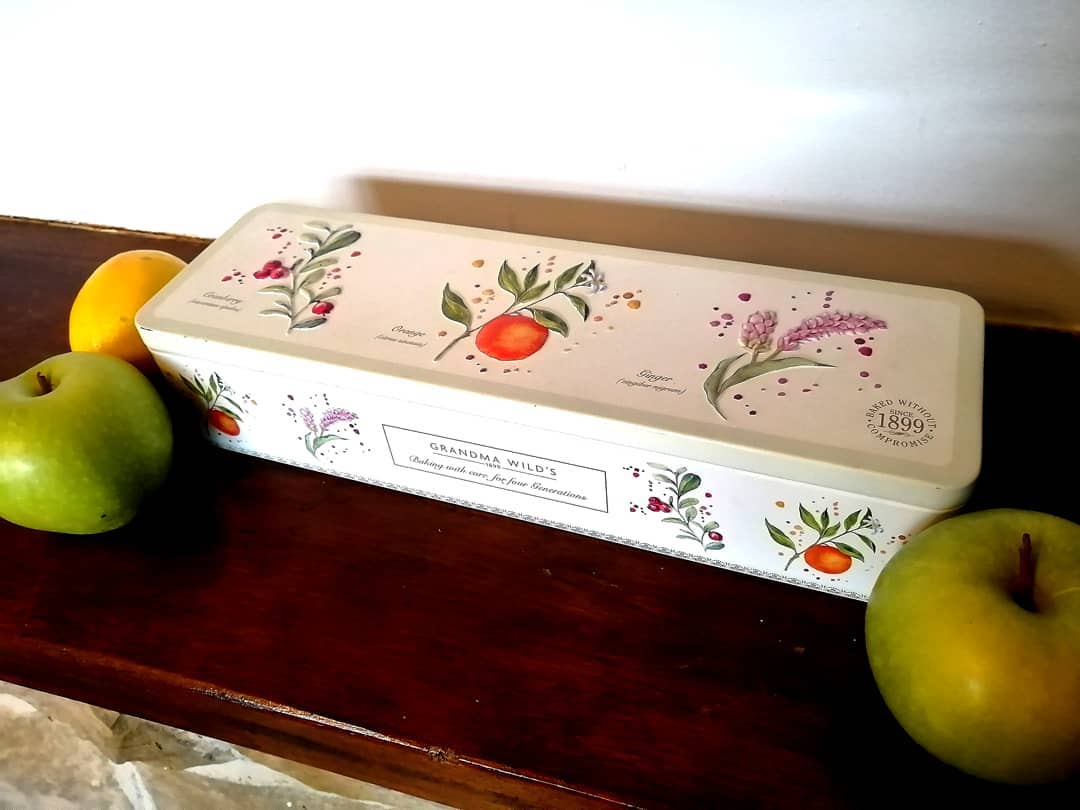I thought it would be nice for a change to take a short text from a classic and analyse it in today’s lesson.
So I have the pleasure of re-introducing one of my top favourite novels, North and South by Elizabeth Gaskell (1810-1865), having been inspired today by this biscuit tin which I bought last year when I visited the Brontes’ home town, Haworth, Yorkshire, in the north of England. I love the pretty watercolour fruits painted on the front and side of the tin, as well as the brand inscription, ‘Grandma Wild’s [biscuits]’. 🍊🍋🍒🍏🍎
I am often reminded of the fact that Elizabeth Gaskell was a good friend of Charlotte Bronte, visited her at her home in Haworth, and even after the latter’s death was asked by Patrick Bronte (Charlotte, Emily, and Anne Bronte’s father) to write a biography of Charlotte. It is for this reason that the biscuit tin reminds me of both writers — the one, for her association with the place where I bought it, and the other, for a memorable passage in her novel about a proud, shy man buying a basketful of fruit for an ill friend. 🥭🍓🍑🍋🍒
📗 But Mr. Thornton had no general benevolence, — no universal philanthropy; few even would have given him credit for strong affections. But he went straight to the first fruit-shop in Milton, and chose out the bunch of purple grapes with the most delicate bloom upon them, — the richest-coloured peaches, — the freshest vine-leaves. They were packed into a basket, and the shopman awaited the answer to his inquiry, ‘Where shall we send them to, sir?’
– Elizabeth Gaskell, North and South (1854)
…
5 OBSERVATIONS
✒️ First observation: This section of the novel is a perfect example of when it makes sense to begin a sentence with a conjunction such as ‘but’. I wrote another lesson on how to use the conjunction ‘and’ correctly (you can find it here), and much of what applies to ‘and’ as explained there will also apply to ‘but’. In short, while it is not always advisable to use a conjunction at the beginning of a sentence, there are times when to do so introduces a sense of continuity or conflict with what went before. In the case of this paragraph starting with ‘but’, readers sense a kind of tension, a feeling that it is not normally like Mr Thornton’s character to be openly philanthropic or generous like this.
✒️ The second ‘but’ introduces another diversion or change from the sentence before. Mr Thornton isn’t a showy man, (‘but’) he does something unusual: he splashes out on buying the best, most luxurious fruit he can find. These kinds of introductions, whenever appropriate of course, help to capture a listener or reader’s attention more effectively.
✒️ Another thing which is noticeable here is Gaskell’s use of repetition: ‘no general benevolence, — no universal philanthropy’. The construction here is ‘no + adjective + noun’, and it helps to emphasise the meaning strongly for readers, especially ‘no’ which is repeated twice. In the next line she also repeats another construction (‘the’ + adjective + noun) when describing the fruits: ‘the richest-coloured peaches, — the freshest vine-leaves’, and again, the definite article ‘the’ is stressed – these peaches and vine-leaves were the best the shop had to offer. In English, when we want to emphasise ‘the’ orally (for example, to say that such peaches were ‘the best’) we pronounce it as ‘thee’ and not the usual ‘thuh’.
✒️ It is interesting to observe how Gaskell uses dashes here in her writing, especially because we would not use them nowadays as she did. Many British writers in the 19th-century were fond of using dashes, perhaps because most Victorian novels or short stories were written to be read aloud, and dashes visually highlight where a reader ought to breathe.
So where Gaskell uses dashes in the passage about Mr Thornton buying fruit, we would use commas nowadays.
When we do use dashes, they usually have one of the two following functions.
1) Dashes highlight an arenthesis, that is, a word or phrase that is either an explanation or afterthought within a longer passage that doesn’t grammatically require it. Brackets, commas, or dashes can do this, and writers often have a preference for one over the other in their writing. For example, the Irish modernist writer James Joyce used many dashes with his arentheses, while British writer Virginia Woolf preferred using commas or occasionally brackets to separate hers.
✍️ My best advice: learn the unique value of dashes, brackets and commas, and use each according to how they best suit your writing structure.
2) Dashes separate a clause from another in a distinctive, contrasting manner.
For example:
📗 “Why on earth has your father fixed on Milton-Northern to live in?’
‘Partly,’ said Margaret, sighing, ‘because it is so very different from Helstone — partly because Mr. Bell says there is an opening there for a private tutor.’
— Elizabeth Gaskell, North and South
✒️ One final observation: don’t confuse dashes with hyphens, which are the shorter lines that join two words together: for example, ‘fruit-shop’, ‘richest-coloured’, ‘vine-leaves’. Dashes are longer and have a space before and after, whereas hyphens are short and do not have any space between them and the words they join together.
…
From a short passage of less than a hundred words, we have been able to identify five points worth observing — the ‘fruits’ of our analytical labour! I hope these have been helpful for you, and as always, I am happy to work with you one-to-one, making sense of longer, more complex texts that will improve your English. (Notice how dashes and hyphens were used in these last lines – I could hardly resist!)




